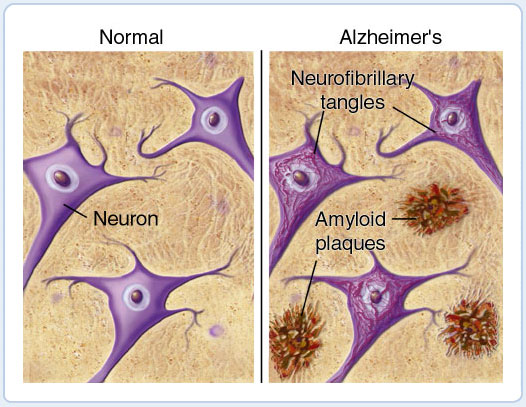If after reading this post you have questions regarding alternative medicine, integrative medicine, chiropractic, weight-loss, diabetes or pre-diabetes prevention, nutritional supplementation or how to become a new patient, please feel free to contact our office. Advanced Healing Center of Orange County, the practice of Dr. Marcus Ettinger BSc, DC. Phone: 714-639-4360, E-mail: info@advancedhealing.com, Mail: 630 South Glassell Street #103. Orange, CA 92866.
 Alzheimer’s disease is a brain disease that causes problems with memory, thinking and behavior. Symptoms usually develop slowly and get worse over time, becoming severe enough to interfere with daily life. Alzheimer’s is the most common form of dementia and is not a normal part of aging. Alzheimer’s disease is progressive and there is no known cure.
Alzheimer’s disease is a brain disease that causes problems with memory, thinking and behavior. Symptoms usually develop slowly and get worse over time, becoming severe enough to interfere with daily life. Alzheimer’s is the most common form of dementia and is not a normal part of aging. Alzheimer’s disease is progressive and there is no known cure.
Alzheimer’s disease occurs when Two abnormal structures called plaques and tangles begin to form in the memory sections of the brain, and begin damaging and killing the nerve cells. Plaques are deposits of a protein fragment called beta-amyloid (BAY-tuh AM-uh-loyd) that builds-up in the spaces between nerve cells. Tangles are twisted fibers of another protein called tau (rhymes with “wow”) that builds-up inside cells. Though most people develop some plaques and tangles as they age, those with Alzheimer’s tend to develop far more. Below is an explanation of how the above occurs and is also one way to increase your odds for developing Alzheimer’s disease. This is also a way to increase your odds of dying of cardiovascular disease, stroke or cancer.
Below is an explanation of how the above occurs and is also one way to increase your odds for developing Alzheimer’s disease. This is also a way to increase your odds of dying of cardiovascular disease, stroke or cancer.
The diabetes, insulin and Alzheimer’s Disease connection – or – How to increase your chances of developing Alzheimer’s disease by living a traditional Western lifestyle.
First, you must eat a standard Western diet, which is also a high glycemic and high fat diet. The standard Western diet contains an over-abundance of added sugar (sucrose); starch; saturated, polyunsaturated and trans-fats (dairy, red meat and hydrogenated vegetable oil), and avoid a Mediterranean diet, which is abundant in fiber; fruits; vegetables; beans/legumes; nuts and seeds and monounsaturated fats (avocado, olive oil and fish rich in Omega 3 fatty acids). Second you must avoid exercise.
Second you must avoid exercise.
Third, you must limit your engagement in mental activities such as, but not limited to: continued education, crossword puzzles and social interactions (out-side of work).
The traditional Western lifestyle is a risk factor for the development of many diseases, and it will definitely contribute to the production of elevated triglyceride (fat) and glucose (sugar) levels in the blood. Elevated glucose in the blood will raise insulin (hormone) levels and is known as type 2 diabetes. When blood glucose is elevated for an extended period of time it begins to bind to the oxygen carrying component of our blood called hemoglobin. This combining of glucose and hemoglobin is known as glycated hemoglobin (glycosylated hemoglobin or A1C), and is a diagnostic marker used to monitor the long-term state (severity or healing) of a diabetes. As the glucose level in the blood increase, so does the concentration of glycated hemoglobin (A1C).
Glycation is a normal chemical reaction that glucose (sugar) will undergo in our body and usually increases as we age. Under certain pathologic conditions such as diabetes this process is abnormally accelerated and will lead to an overabundant production of a destructive class of chemicals known as advanced glycation end-products (AGEs). Some AGEs are benign, but others are more reactive than the sugars they are derived from, and are implicated in many age-related chronic diseases such as: cardiovascular diseases (the endothelium, fibrinogen, and collagen are damaged), Alzheimer’s disease (amyloid proteins are side-products of the reactions progressing to AGEs), cancer (acrylamide and other side-products are released), peripheral neuropathy (the myelin is attacked), and other sensory losses such as deafness (due to demyelination of auditory nerves). This range of diseases is the result of the very basic level at which glycations interfere with molecular and cellular functioning throughout the body and the release of highly-oxidizing side-products such as hydrogen peroxide.
Another pathologic component derived from following the above lifestyle (lack of exercise, high blood triglyceride and glucose levels) is an increase in IGF-1 production and a reduction in the passage IGF-1 into the brain. IGF-1 possesses many functions but in this context we are looking at its neuroprotective ability to inhibit the formation of beta-amyloid plaque and tau in the brain, which can lead to the development of Alzheimer’s disease.
In summary, Reducing blood levels of triglycerides (below 150 mg/dL) and glucose levels (below 96 mg/dL); engaging in regular exercise (exercise increases the neuroprotective hormone Insulin-like-Growth-Factor’s passage into the brain) and continued education, will lower the risk for developing Alzheimer’s disease.